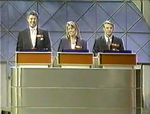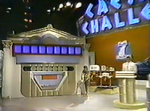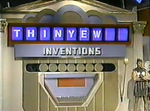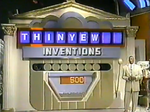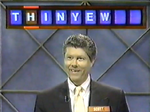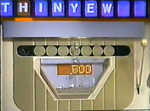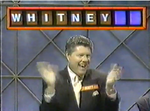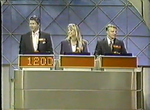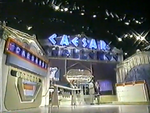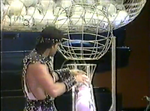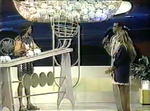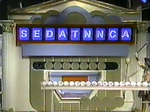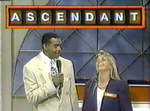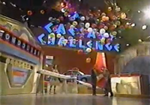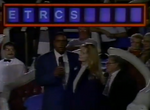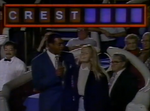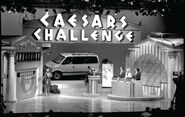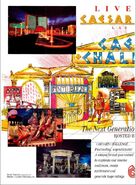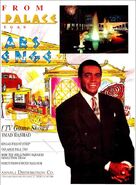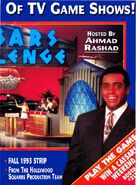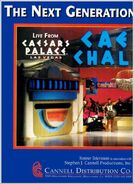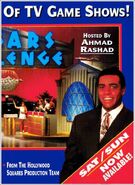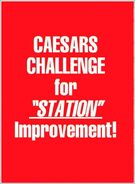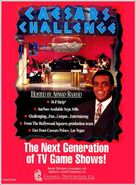| Host | |
| Ahmad Rashād | |
| Co-Hosts | |
| Dan Doherty Zach Ruby (pilot) Chad Brown (first week) | |
| Announcer | |
| Steve Day | |
| Broadcast | |
| Pilot: 10/1992 NBC Daytime: 6/14/1993 – 1/14/1994 | |
| Packagers | |
| Rosner Television Stephen J. Cannell Productions | |
"From the entertainment jackpot/resort capital of the world, Caesars Palace in Las Vegas, Nevada, it's the exciting, new, prize maximus, letter-perfect game show, Caesars Challenge! Ladies and gentlemen, Ahmad Rashād!"
Caesars Challenge was a game show set in Las Vegas, NV, where three contestants played anagrams mixed with trivia.
Gameplay[]
Front Game[]
Three contestants competed, one a returning champion (or designate if a previous champion had retired).
Three rounds were played. The object in each round was to solve a jumbled word displayed on a 9-screen slot machine on stage. Seven-letter words were used in Round 1, eight-letter words in Round 2 and nine-letter words in Round 3.
Each new word fit into a category that was originally revealed to everyone, but later only revealed to home viewers. Rashād asked the players a toss-up question with three choices based on the category, and a player who buzzed in with the correct answer won money and chose a letter to place in its correct position in the word. If two players gave incorrect responses, the third player won the money and the choice of letter by default.
The player had five seconds to guess the word, and, if correct, won additional money based on the unplaced letters left in the word. If they did not guess the word, questions and letter selections continued until someone guessed it. Two words were played in each of the first two rounds. Round 3 included as many words as time allowed.
During the time when the category was only revealed to the home audience, Rashād announced the category of the word to the contestants after the word had been correctly guessed.
Scoring[]
| Rounds | Number of Letters in the Word | Value (x Unplaced Letters) | Maximum Value |
|---|---|---|---|
| Round 1 | 7 Letters
|
$100
|
$700
|
| Round 2 | 8 Letters
|
$200
|
$1,600
|
| Round 3 | 9 Letters
|
$300
|
$2,700
|
Lucky Slot[]
One position in the word was signified as the Lucky Slot. If, after choosing a letter whose correct position was the Lucky Slot (signified by a siren and coins dropping below), a contestant guessed the word correctly, they won additional money. Each show began with a Lucky Slot bonus of $500, and $500 was added to the bonus after each word until it was won, at which point the bonus reset to $500.
Speed-Up round[]
When time was running short (signified by the car horn from the Davidson version of Hollywood Squares), letters were placed automatically into the current word and the first contestant that buzzed in with the correct answer won money based on the unplaced letters. An incorrect answer locked that player out of play. The Lucky Slot was out of play during the speed-up round.
Winning[]
The player with the most money at the end of the game won and advanced to the Bonus Round. Originally, the winner shopped for prizes a la classic Wheel of Fortune. Later, they were given a prize package equal to their score, up to $10,000. In either case, no actual cash prizes were awarded. The other players left with parting gifts, including dinner for two and tickets to a headliner show at the Circus Maximus showroom at Caesars Palace. In the case of a tie, another speed-up round was played between the tied players.
Bonus Round (The Tournament)[]
Format #1[]
A giant rotating bingo cage filled with 200 lettered balls was lowered from the ceiling. One ball at a time, each letter was dispensed into a chute to roll down a ramp as Doherty announced each letter. An offstage computer kept track of each letter as it was announced, searching the sequence for at least one valid nine-letter dictionary-certified word that could be formed from them. Once any such word had been found, the cage stopped rotating, a gong sounded and a booming voice (announcer Steve Day) announced "Caesar says STOP!"
The producers then chose the word and the nine letters in that word were then placed on the slot machine in the order that they rolled down the ramp. Contestants were allowed to place one letter in its correct position for each day they had been on the show. The contestant then had 10 seconds to try to solve the word. If the contestant solved the word correctly, they won a new car and retired as champion; otherwise, they returned on the next show.
Partway through the show's run, the drawing began in the moments leading into the final commercial break before the bonus round, in order to save time. The letters were announced and shown to the audience as they were drawn.
Format #2[]
The champion faced a game board with five words. The first word had five letters, the second had six, and so on up to the fifth word consisting of nine letters. The first word would shuffle its letters (similar to the Speed-Up Round), placing a letter in its correct position each time. After each correct guess, the contestant moved on to the next word. Guessing all five words in 30 seconds won the car.
In the beginning, the words were displayed on a monitor. Later the scrambled words were revealed on a green screen. It is not known if that the same monitor remained.
Starting with the introduction of this bonus round, the champion was now limited to a maximum of three consecutive appearances or until they won a car, whichever came first.
Audience Game[]
During the closing credits of every show, Rashād and Doherty went into the studio audience and gave audience members an opportunity to unscramble five-letter words. Correctly guessing the word won a handful of Caesars Palace casino chips, silver dollar coins and gold foil-covered chocolate medallions from a bowl held by Doherty.
Pilot[]
The show's pilot, taped in 1992 and which apparently aired during the run, contained several differences from the actual series.
The biggest change was a "betting" format; while individual questions were still worth $100/$200/$300, players started with $2,500 and could bet up to a certain limit whether they could guess the word or not, using keypads in front of them. For the first three words, the maximum bet was $250 and the payoff was 2:1. After that, the limit increased to $500. For the fifth word on, the odds increased to 3:1.
In addition, the Lucky Slot carried over from the previous show. Finally, there was no Speed-Up Round, and in the audience game, only casino chips were offered as prizes.
At the end of the credits, the airplane that was previously seen on Personals is used on the production company's logo.
Gallery[]
Trade Ads[]
Trivia[]
As seen in the ads above, the show was originally pitched for first-run syndication.
This was the only game show that features male models as female models were never hired.
Like most other Rosner game shows, when the car was won, balloons were released. More often than not, however, they would still be left on the floor when the next episode began.
This was the last network daytime game show on air (except for The Price is Right) until Let's Make a Deal hosted by Wayne Brady came along since 2009 on CBS.
All of the contestants were chosen from the audience at Caesars Palace.
Despite the show being produced by Stephen J. Cannell productions, this was the only show from the company's library to NOT feature the famous logo of Cannell in his office on his typewriter.
The "Caesars" in both the show's name as well as the "Caesars Palace" name are NOT possessive; many people have thought the name contains an apostrophe.
Music[]
Stormy Sacks
Inventors[]
Rick Rosner & Mike Dubelko
Studio[]
Caesars Palace, Las Vegas, NV
Episode status[]
All episodes exist. Reruns aired on the USA Network from June 27 to November 4, 1994.
External Links[]
- Caesars Challenge fanpage
- Rules for Caesars Challenge
- Another Caesars Challenge Rules Page
- Sounds from the show
- Flash game of the first bonus round
- Game Show Temple: Caesars Challenge
YouTube Videos[]
1992 pilot episode (1/3)
1992 pilot episode (2/3)
1992 pilot episode (3/3)
6/14/93 premiere (1/4)
6/14/93 premiere (2/4)
6/14/93 premiere (3/4)
6/14/93 premiere (4/4)
Neil Bines dominates the game!
First bonus round format
Second bonus round format
| This page uses Creative Commons Licensed content from Wikipedia (view authors). |

